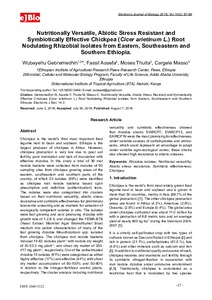| dc.contributor.author | Gebremedhin, W. |
| dc.contributor.author | Assefa, F. |
| dc.contributor.author | Thuita, M. |
| dc.contributor.author | Masso, C. |
| dc.date.accessioned | 2019-12-04T11:27:27Z |
| dc.date.available | 2019-12-04T11:27:27Z |
| dc.date.issued | 2018-11 |
| dc.identifier.citation | Gebremedhin, W., Assefa, F., Thuita, M. & Masso, C. (2018). Nutritionally versatile, abiotic stress resistant and symbiotically effective chickpea (Cicer arietinum L.) root nodulating rhizobial isolates from eastern, southeastern and southern Ethiopia. Electronic Journal of Biology, 14(2), 87-99. |
| dc.identifier.issn | 1860-3122 |
| dc.identifier.uri | https://hdl.handle.net/20.500.12478/4940 |
| dc.description | Open Access Journal; Published online: 7 Aug 2018 |
| dc.description.abstract | Chickpea is the world’s third most important food legume next to bean and soybean. Ethiopia is the largest producer of chickpea in Africa. However, chickpea production is very low due to poor soil fertility, poor nodulation and lack of inoculation with effective rhizobia. In this study a total of 39 root nodule bacteria were collected from nodules of 60 sampling sites from chickpea growing areas of the eastern, southeastern and southern parts of the country, of which 23 isolates (59%) were identified as chickpea root nodule bacteria based upon presumptive and definitive (authentication) tests. The isolates were also categorized into clusters
based on their nutritional versatility, abiotic stress resistance and symbiotic effectiveness for preliminary taxonomic screening and as markers for selection of ecologically competent isolates in vitro. The isolates were fast growing and acid producing rhizobia with growth rate of 1-2.8 h, and changed the YEMA-BTB (Yeast Extract Mannitol Agar Bromothymol Blue) medium into yellow characteristics of many of the fast growing rhizobia Mesothizobium spp. isolated from chickpea. The chickpea root nodule bacteria induced 14-62 nodules plant-1 with nodule dry weight of 20-53.3 mg plant-1; and shoot dry matter of 250-417 mg plant-1, respectively. Out of the authenticated rhizobia 14 isolates (61%) were categorized as either highly effective (17%) and effective (44%) with shoot dry matter accumulation of 80-100% and 50-80% in relation to the nitrogen-fertilized control plants, respectively. The cluster analysis including nutritional versatility and symbiotic effectiveness showed that rhizobia strains EIARCP7, EIARCP13, and EAIRCP19 were the most promising for effectiveness under variable sources of carbohydrates and aminoacids,
which could represent an advantage to adapt under variable agro-ecological zones; these strains also showed high resistance to abiotic stresses. |
| dc.description.sponsorship | Bill & Melinda Gates Foundation |
| dc.format.extent | 87-99 |
| dc.language.iso | en |
| dc.rights | CC-BY-4.0 |
| dc.subject | Rhizobiaceae |
| dc.subject | Nutrition |
| dc.subject | Abiotic Stress |
| dc.subject | Chickpeas |
| dc.subject | Grain Legumes |
| dc.subject | Ethiopia |
| dc.title | Nutritionally versatile, abiotic stress resistant and symbiotically effective chickpea (Cicer arietinum L.) root nodulating rhizobial isolates from eastern, southeastern and southern Ethiopia. |
| dc.type | Journal Article |
| dc.description.version | Peer Review |
| cg.contributor.crp | Grain Legumes and Dryland Cereals |
| cg.contributor.crp | Roots, Tubers and Bananas |
| cg.contributor.affiliation | Ethiopian Institute of Agricultural Research Pawe Research Center |
| cg.contributor.affiliation | Addis Ababa University |
| cg.contributor.affiliation | International Institute of Tropical Agriculture |
| cg.coverage.region | Africa |
| cg.coverage.region | East Africa |
| cg.coverage.country | Ethiopia |
| cg.creator.identifier | Moses Thuita: 0000-0002-6731-9492 |
| cg.creator.identifier | Cargele Masso: 0000-0002-3980-6832 |
| cg.researchtheme | NATURAL RESOURCE MANAGEMENT |
| cg.isijournal | ISI Journal |
| cg.authorship.types | CGIAR and developing country institute |
| cg.iitasubject | Grain Legumes |
| cg.iitasubject | Natural Resource Management |
| cg.journal | Electronic Journal of Biology |
| cg.howpublished | Formally Published |
| cg.accessibilitystatus | Open Access |
| local.dspaceid | 101942 |
| cg.targetaudience | Scientists |

